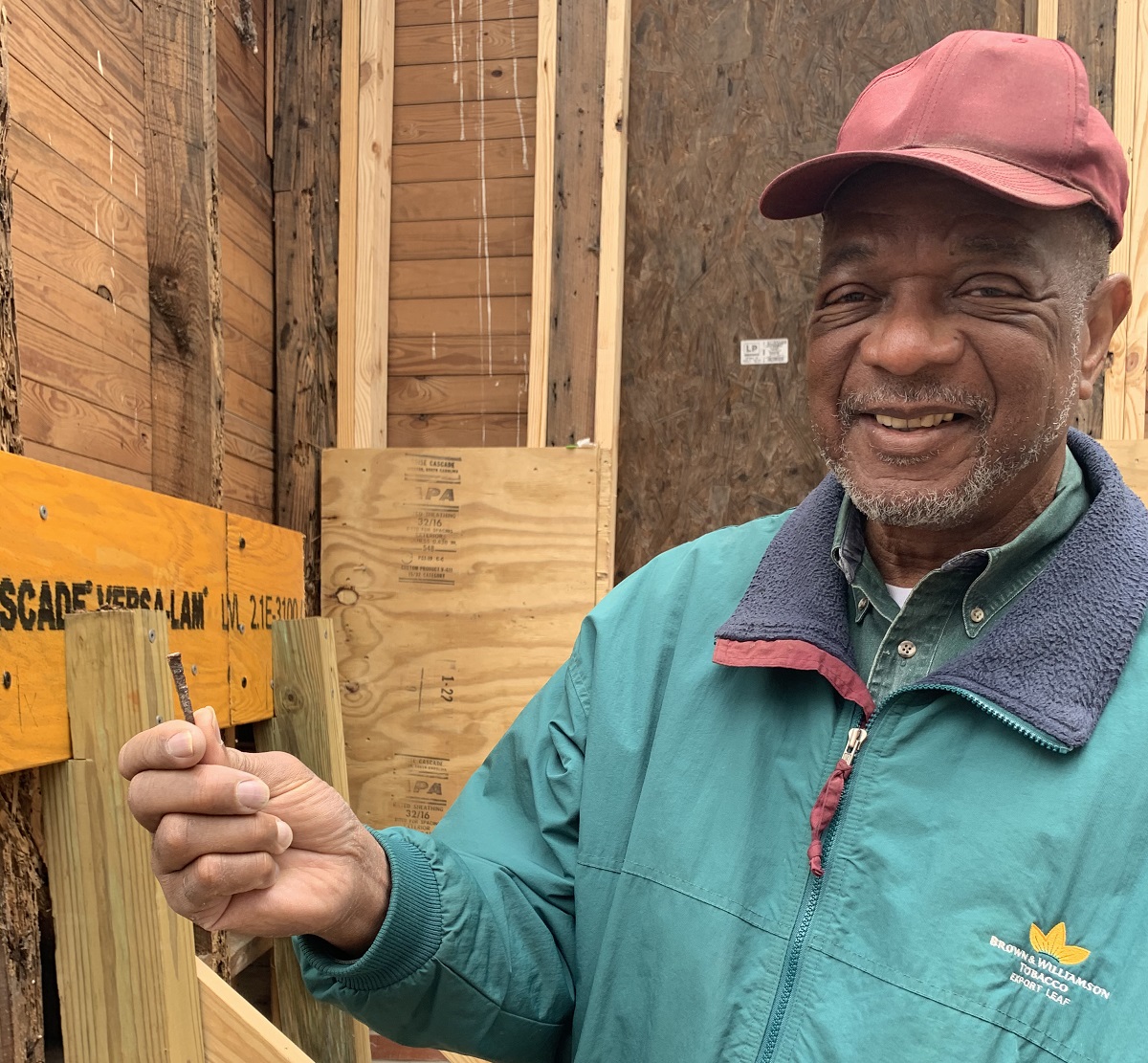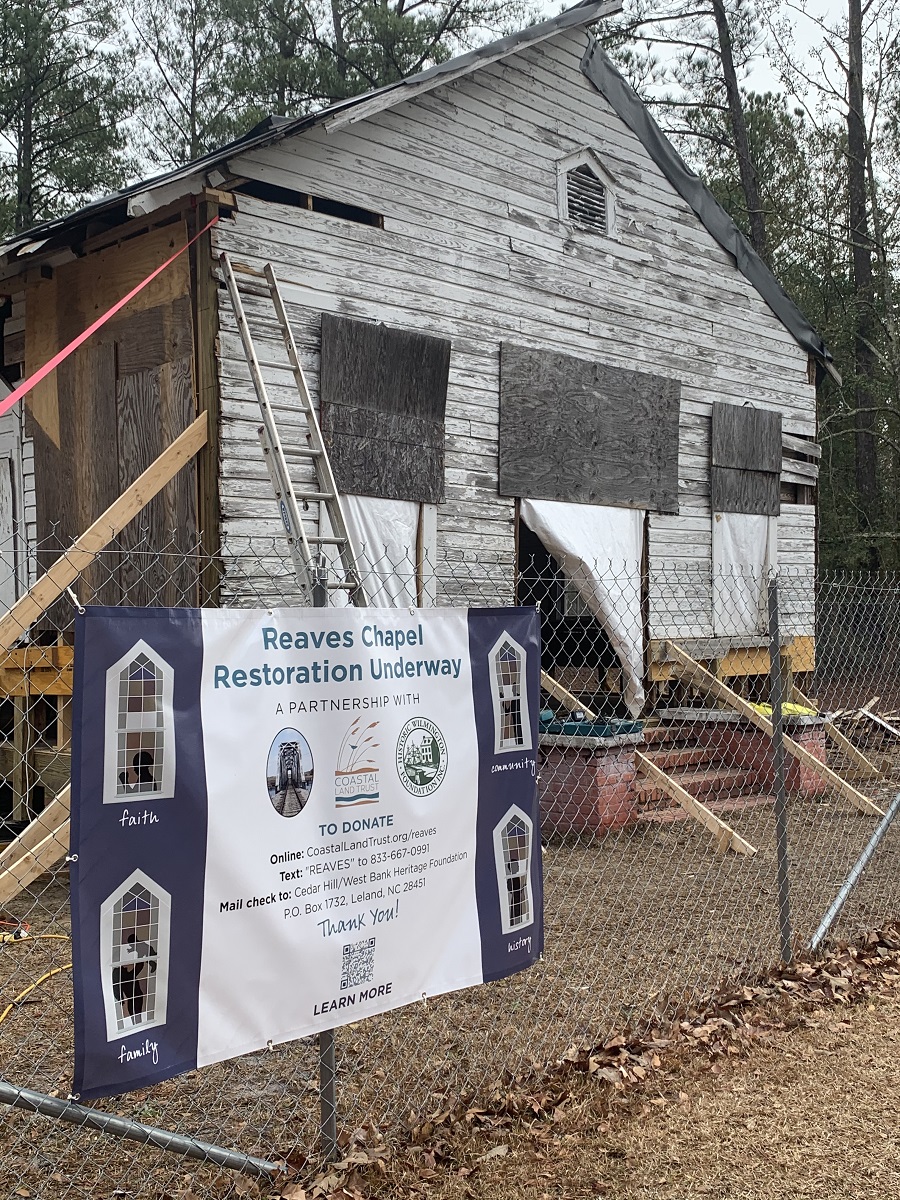
NAVASSA – There have been times when Al Beatty has been afraid to look at Reaves Chapel as he’s driven by.
Jesica Blake felt a swift wave of nausea when she watched the chapel, built in the mid-1800s, visibly shake as its steeple was lifted off the roof a couple of years ago.
Supporter Spotlight
More than one conversation between the two have started with the question, “Is it still standing?”
Remarkably, Reaves Chapel, one of the oldest African American buildings in southeastern North Carolina is, indeed, still standing after falling into dilapidation since a congregation last met within its walls more than 15 years ago.
Since then, the small chapel built by people formerly enslaved at Cedar Hill Plantation has weathered tropical storms and hurricanes. Termites have feasted on its wooden bones.
The weight of the steeple, which holds a small, but impressively heavy bell, began to cause the chapel to tilt to one side.
The race against time to restore the chapel before it toppled to the ground weighed heavy on Beatty, president of the Cedar Hill/West Bank Heritage Foundation, and Blake, North Carolina Coastal Land Trust associate director.
Supporter Spotlight
“It would have never survived another tropical storm,” Beatty said, surveying the chapel’s new flooring on a recent, cold February morning.
It was the first time he walked inside the chapel, its floor too rotted to safely hold a person, in more than a year.
“This is fantastic,” Beatty said, a smile beaming across his face. “It’s past great. It’s fantastic.”
Roughly half of the $1 million it will cost to restore the building, landscape the chapel’s grounds, build a separate building for restrooms and a parking lot, has been collected through fundraising efforts headed by the land trust, foundation and Historic Wilmington Foundation.
The Coastal Land Trust purchased the little more than half an acre on which the chapel now sits just off Cedar Hill Road in Navassa, the Brunswick County town nestled at the confluence of the Cape Fear and Brunswick rivers.
Ed Reaves, a former Cedar Hill Plantation slave, donated the land in 1911, which was around the time the chapel was relocated by its congregation, the members of which used logs and a team of oxen, to move it inland from the bluffs of the Cape Fear River.
The church eventually became affiliated with the African Methodist Episcopal denomination and remained an AME church until its doors closed permanently in the mid-2000s.
As a child, Beatty attended the church with his family. He recalls the Easter Sunday programs when he and the other children, dressed in their Sunday best, had to recite short speeches intertwined with scripture, from the pulpit.
“Everybody had a speech,” Beatty said. “Everyone.”
Beatty helped form the Cedar Hill/West Bank Foundation in 2011 in an effort to save the chapel. The foundation officially gained nonprofit status two years later.
Early attempts to buy the chapel were unsuccessful. The land trust, which had been working with Navassa as the town began going through a process with the U.S. Environmental Protection Agency to remediate the former Kerr-McGee Superfund Site, eventually stepped in and offered to help pick up the cause to save the chapel, purchasing the land with a grant from the Orton Foundation.
“It’s a piece of American history that we are honored to help protect,” Blake said.

The church is being restored to how it was in 1911, when a cubby-like addition was built at the front of the church to hold a choir.
Today, the chapel’s white paint is grayed and chipped. Evidence of water damage marks parts of the ceiling and walls.
Portions of exposed, wooden frame of the building are peppered with holes gnawed by termites. “Real, old-fashioned nails,” as Beatty refers to them, still hold the frame together.
But the bones are good, a testament to the craftsmen who built the chapel more than a century ago.
Beatty said he’s yet to bring first-time visitors to the chapel who were not immediately drawn to its allure.
“The church becomes a part of them,” he said.
Balding Brothers, a Wilmington-based company that specializes in historic building restoration, is overseeing the project.
Since restoration work began late last year, the church’s foundation has been stabilized by some of the original concrete blocks that have held up the church for years. New, brick pilings have been added along the foundation’s sides.
Three stain glass windows, including a triangular-shaped window over the double-door entrance, have been removed and sent off for cleaning and restoration at a hefty price tag of $50,000.
A shipping container next to the chapel, which is enclosed temporarily by a tall, chain link fence, is used as storage for items taken out of the chapel, such as pews and the steeple bell.
Out of site of the chapel grounds, back in the woods that lead to the Cape Fear River bluffs, is the chapel cemetery.
About 10 or so headstones are in that area. More than 70 depressions in the ground signal more graves.
“We are in the process of restoring that and getting a catalog,” of those graves, Beatty said.
The organizations are working with the North Carolina State Historic Preservation Office to have the chapel and its cemetery designated a state historic site, one that would eventually be tied in with nationally-recognized places of historic significance related to the Gullah Geechee.
Gullah Geechee are descendants of West Africans taken from their country and enslaved on rice, indigo and Sea Island cotton plantations of the lower Atlantic coast.
Reaves Chapel would be the northern anchor of the Gullah Geechee Cultural Heritage Corridor, which encompasses 12,000 square miles of coastal area that runs up the southern Atlantic Coast from St. John’s County, Florida, to Onslow County.
Efforts are underway to connect the corridor with the East Coast Greenway in Brunswick County. The greenway is a 3,000-mile walking and biking route that runs through 15 states from Maine to Florida.
The Gullah Geechee Greenway/Blueway Heritage Trail project will be designed to intertwine outdoor activities, including walking, bicycling and paddling, with the history and culture of the Gullah Geechee.
There is also a proposal in the works to build in Navassa a cultural heritage center, a place that will further educate visitors about the history and culture of the Gullah Geechee.
Blake said the goal is to get the state to take ownership of the chapel. Ultimately, Beatty said, the plan is to get the site on the National Park Service’s National Register Historic of Historic Places.
Blake said, though lofty, she hopes the chapel restoration will be complete by year’s end.







